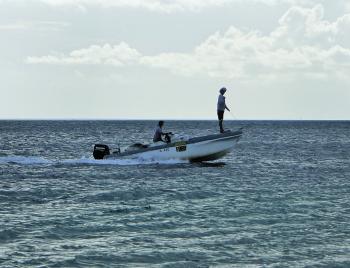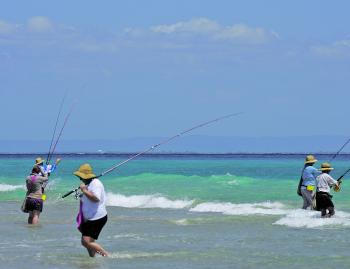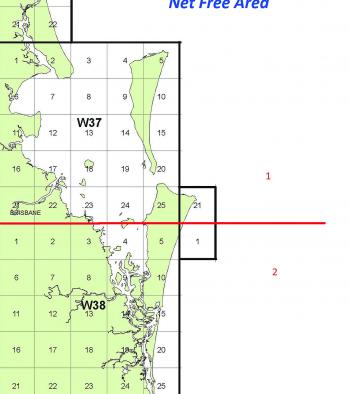I just spent a week on Moreton Island with my extended family. What we saw never ceases to amaze me. Commercial netters worked the beach from Tangalooma to North Point and did their best to not leave a single whiting. They cruised the shallows in the crystal clear water and targeted every last one they saw. There is no resource sharing and the long-term irreversible impacts they are having on the natural ecosystems are completely unknown.
At the last Queensland state election the current government made a policy commitment to Net Free Areas in areas of high recreational and environmental value. They committed to Cairns, Mackay and Keppel Bay and to then commence an investigation in Moreton Bay.
This decision was based on sound economic and environmental indicators and solid support from local communities, recreational fishing and tourism. The three in the north have been done and now Moreton Bay needs to be done. It needs to happen now. The condition of Moreton Bay coastal beach fishing is beyond critical. We can’t afford to wait on a promise for another election.
It is now an accepted fact that the economic and social benefits of recreational fishing can exceed the economic value to the community of commercial net fishing in high population areas, and at considerably less expense to the environment.
Many people acknowledge that commercial fishing in one form or another (including aquaculture) is a valid method for providing quality seafood to the non-fishing community. The Sunfish preferred option would be for that to be provided by aquaculture or line caught and provided to a domestic market only.
Historically, areas that are fished by both recreational and commercial fishers at high density become confrontational or unfriendly at best. Recently it has become scientifically supported that commercial entanglement netting (not tunnel netting) is an activity that should not be in areas that are also high population areas for turtles, dolphins or dugongs.
In 2003 the National Recreational and Indigenous Fishing Survey (funded by the Natural Heritage Trust) identified the importance of recreational fishing to regional economies. The survey stated 33% of Queensland households had at least one member who had fished in the last 12 months. The survey stated further that 60% of the catch was sourced from estuaries.
Estimates of the direct cost or expenditure for recreational fishers targeting barramundi suggest a value of approximately $51 per recreational fish as opposed to $19 per commercial fish (assuming a weight of 3kg).
State governments (in particular the NT) have been prudent to recognize the recreational fishing contribution to local economies. In Darwin for example, it’s claimed each recreationally caught barramundi is currently worth $3500 to Darwin’s economy.
Some of the key issues identified in two separate surveys of local retail outlets were: consistency of local product availability was at the best limited to 50% of outlets; and common local fish such as fresh whole whiting, bream, flathead and snapper were stocked only by 20% or less of outlets.
The statement that commercial operators supply the public has limited validity as local product availability was low – only 50% of surveyed outlets stocked one or more local fish species. In most cases the cost was well above non-local product – prime fish was very expensive – whiting fillets were $45, snapper fillets $39, scallops $59, flathead fillets $38 and mud crabs $50, making them almost a luxury buy. The bottom line is that very little of the fish gill netted find their way onto local tables.
Recreational fishing tourism is for today and tomorrow and the next day. This is all of us, unless you live on a creek and never fish anywhere else. We pay to travel to our favourite spots, whether it is fuel for the car and boat, barge fees or plane tickets.
With increasing population densities, Moreton Bay is one of few remaining safe areas for families to fish that is reasonably accessible from all of Brisbane and the surrounding regions. Every year hundreds of kids learn to fish in Moreton Bay.
Records indicate that Moreton Island alone attracts on average 80% non-residents on any given day. When considering recreational fishing tourism, some of the items to be valued include: fresh fish on the table; healthy activity for any individual irrespective of physical or intellectual capacity, age, sex or socio-economic status; tackle bought, bait, fishing apparatus, boats, fuel; vehicles specific for fishing; accommodation, meals and transport costs to access the island.
Because of the limited access and the National Park designation, these commercial enterprises are limited in number and nature on Moreton Island. Many of the purchases are therefore bought in local communities prior to departing for the island. This means that a significant reduction in recreational fishing tourists will not only impact Moreton Island Ferries and local Moreton Island businesses, but businesses throughout the greater catchment area.
Currently it is almost impossible to catch a legal-sized whiting on Moreton or Bribie islands on beaches open to netting in what is their peak season. In addition, the whiting being netted are not appearing in local markets, but we have reason to believe they’re going directly to Sydney markets.
Both of these islands are National Parks designated for recreational use. Many trips to these national parks include fishing as one activity. At the moment the benefit of this is being denied them.
In Moreton Bay, like many other population centres, we are becoming increasingly aware of areas of localized depletion resulting from concentrated, repetitive commercial gill netting. I witnessed this recently and spoke to several groups fishing on the same 500m of beach who indicated that, contrary to previous trips, they had been unable to catch anything of a legal size. Between them they had spent $6000 on their trips that week.
Fisheries Queensland do not have a mechanism for either measuring or managing localized depletion at this point in time.
We are not asking for access to existing green zones within the area we have highlighted, but just to ensure that in future they will remain clear of commercial fishing should the zonings change.
Commercial catch data on the Fisheries Queensland website is quite coarse. As a result, the figures we have been able to extrapolate include the tunnel netters and offshore netters in grids W36, W37 and W38 (Moreton Bay Marine Park) who will not be impacted. As a result the catch estimates we are using will be significantly higher than reality. In 2013 about 1384t was recorded in logbooks in these grids. This equates to about $6.9 million to the fishers.
Last financial year the recreational boat owners in the Moreton Bay catchment area paid over $2 million in the Recreational Use Fee that is included as part of their boat registrations. Given the number of years that these contributions have been coming from the recreational sector, it is certainly fair and reasonable that we see this net-free area sooner rather than later.
Now, it would be preposterous to think that recreational fishing policies are significant enough to be a major vote winner in the same class as health, roads or education, but with the changing patterns of how people vote, important local issues like recreational fishing have greater significance.
Of all 93 proposed Queensland electorates, there are only four that don’t have a boundary within 100km of the coastline. Of all 93 proposed Queensland electorates, 63 in the 2015 election had margins less than the number of recreational fishers according to Fisheries Queensland’s latest recreational fishing survey data. Any one of those 63 could have changed the outcome of the election. All 63 of those sitting members could have or may indeed have changed with the recreational fishing vote.
Please share this information with any local members or candidates. It’s very important that each of us take the time to go and have a chat with and get to know our local members of council, state and federal government and explain who we are, what we like to do in our spare time and the part they play in achieving that outcome. You can also share the valuable financial benefit to local communities from recreational fishing.
We have recently seen much in local media by fringe commercial fishing groups. In the coming months, I expect there will be more scare mongering.
There are 405,000 recreational fishers in the Moreton Bay Catchment. Again, we are not asking for access to existing green zones in this proposal. Fish caught in the proposed net-free area are generally not supplying the local markets. Last year, more than $2 million in Recreational Use Fees was collected from boat owners in the Moreton Bay Catchment.
Moreton Bay coastal communities will begin to thrive on the combination of a high value recreationally significant net-free area and some modern, environmentally sound and sustainable commercial fishing businesses. This is a unique opportunity for recreational fishing tourism and all the allied industries. The Queensland recreational fishing sector generates expenditure well in excess of $600 million annually.
The best independent economic study was done in 2000, and is reported in the national recreational fishing survey by Henry and Lyle. The survey estimated the numbers of recreational fishers in each state/territory, and what these fishers spent annually. The fishing expenditure covered included accommodation, camping gear, bait, boat, clothing, dive gear, fees, fishing gear, travel, and other costs. The average expenditure per QLD angler in 2000 was $407 annually. The total expenditure in 2000 by all QLD resident recreational fishers was estimated as $320 million.
The present QLD recreational fishing survey being done by DAF estimates there are more than 600,000 recreational fishers in QLD. The best estimate of expenditure per angler in 2014 is given on an Australian Government website as about $1000 annually. This covers the same items as covered in the 2000 national survey.
So a reasonable estimate of current expenditure by the Queensland recreational fishing sector is $600 million annually – almost double the 2000 estimate. This expenditure includes a GST component and none of the expenditure is tax deductible for anglers or subsidized. There is also a non-resident/tourist component, which is currently unknown, but significant.
As mentioned previously, fisheries managers do not have the tools to measure or manage localized depletion. To add salt to the wounds, the whiting netted by the beach gillnetters did not generally appear in the numbers they should have in local markets. The bulk was sent directly to Sydney markets and what little was to be found here was being sold at up to $48/kg for fillets, well out of reach of the average family.
We have been meeting with various sitting and potential Queensland politicians to explain the rationale behind our proposal, and to this date they appear to have been supportive of the reasonable and conservative approach that we are suggesting.
We need a significant show of support to demonstrate the importance of recreational fishing and the value to our community of recreational fishing tourism. Please don’t assume that our political representatives either know or acknowledge this. Also please do not assume that it is so obvious a solution that lots of people will raise their voice. We need you and your family to do so for the future of recreational fishing in Moreton Bay for our children and theirs. Please like our Facebook page, www.facebook.com/MoretonBayRereationalFishingArea.
Reads: 3888
Commercial netters spotting along the shallows.

Anglers at Moreton are struggling to find the legal-sized whiting that should be in great numbers.

The proposed net free area.




